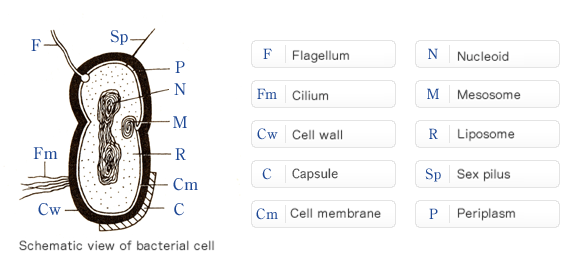General information on bacteria and biofilm
Bacteria

A type of procaryotes, Monad. In general, a cell has a cell wall on the outside. The tissue can be seen by Gram staining. Gram-positive bacteria are composed of peptidoglycan and teichoic acids, and other substances, while Gram-negative bacteria are composed of a comparatively small amount of peptidoglycan and lypopolysaccharides, and lipoproteins.
Most bacteria are either rod-shaped, spherical, or spiral-shaped, and are 0.5 to 1 µm in diameter.
Around the cell, slime layers are produced. They may be polypeptides or polysaccharides. When the slime layers enclose bacterial cells in a form of membrane, they are called capsules. (Source: Iwanami Biology Dictionary)
General bacteria
The term “general bacteria” refers to all bacteria that form colonies in a culture when incubated at 36±1°C for 24±2 hours using a standard agar culture.
General bacteria can be classified into three groups: aquatic bacterial group, soil-derived bacterial group, and sewage-derived bacterial group.
In the tap water quality standard, it is prescribed that “the number of colonies in 1 mL is not more than 100 (100 CFU/mL or less).”
Heterotrophic Plate Bacteria: HPC
All bacteria that form colonies in cultures when incubated at a low temperature for a long time (20 to 28°C for 5 to 7 days) using a culture containing organic nutrients in comparatively low concentration. HPC can proliferate even in low-temperature water environments where general bacteria have difficulty growing. HPC are known as an organic pollution indicator or an indicator that provides information on the hygienic condition of water-distribution and water supply systems.
What is the Biofilm?
Whether an artificial or natural environment, biofilms widely exist where various solid surfaces come in contact with water.
The slime found on river stones, kitchens and bathrooms, oral plaque and the like are called biofilms as biofilms everywhere can be found everywhere.
Biofilms are useful to environmental purification, food production, etc., but on the other hand, the cause infections, tooth decay, metal corrosion and other adverse effects, and sometimes are harmful to humans.
In general, microorganisms such as bacteria adhere to a variety of solid surfaces, form dense aggregations (colonies), and exchange information with one another via a certain kind of substance.
When these microorganisms exceed a certain level, they concurrently excrete polysaccharides outside of the cells in order to form a better growth/proliferation environment. These polysaccharides form biofilms.
Biofilms formed in this way firmly attach to surfaces and work to protect microorganism groups living underneath the biofilms against various stresses such as disinfectants and antimicrobial agents.
